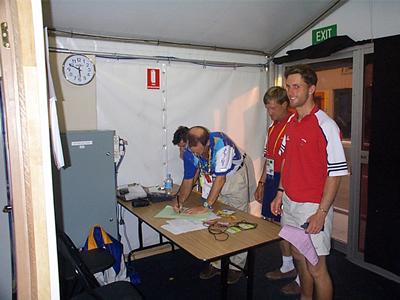
Statistical support for GH-2000 was provided by Professor Phillip Brown and Dr Eryl Bassett from University of Kent. They examined the responses of 17 bio-markers to one month’s administration of recombinant growth hormone (rhGH) (low and high doses) in a double-blind randomised control trial. From these data they developed discriminant functions for men and women that could accurately predict from a single blood sample, whether or not the individual had received GH. They found that it was strictly only necessary to use two of the bio-markers (IGF-I and P-III-NP) to predict accurately treatment group with a very high degree of certainty.
At this stage the IOC did not deal in ‘probabilities’ and were only interested whether the athlete was guilty or not. It took time and debate before a workshop was arranged with IOC lawyers (Denis Oswald) in 1998 and a provisional recommendation made that we should be aiming to work at a 99.99 % probability of being ‘right’ (1 in 10,000 chance of being wrong); hence there is a 1 in 10,000 false positive rate if the athlete is innocent. Although this level of probability was never officially ratified by the IOC, it has been accepted de facto by WADA and CAS and has been the standard to which all subsequent work has been judged.
Statistical support has been invaluable throughout the project and WADA took advantage of Eryl Bassett’s experience on a number of other issues. As a result of rulings from the Court of Arbitration in Sport (CAS) all anti-doping tests have to be carefully evaluated against a large ‘control’ group of elite athletes. The original GH-2000 ‘Cross-Sectional’ study examined bio-marker levels in 813 elite athletes (537 men and 276 women) and defined statistical limits for each sex but following a recent CAS ruling, decision limits are now determined from a reference group of at least 1,000 athletes of each sex.
Following the retirement of Eryl Bassett in 2012, we welcomed Professor Dankmar Böhning and Dr Tan Böhning from the University of Southampton Statistical Sciences Research Institute to our team.
Following the introduction of the GH-2000 biomarker test at the London Olympic Games, there have been several forced assay changes, the introduction of a mass spectrometry method for IGF-I and implementation of the CAS recommendation on reference sample size. This has meant assaying a large number of control samples from elite athletes using all assays and the generation of new decision limits based upon the GH-2000 score for a number of assay pairs. This has involved a large amount of GH-2000 score modelling and analysis and then obtaining approval from WADA to allow an update the method guidelines before the method can be re-introduced and rolled-out to WADA laboratories. This work was published in Drugs Testing and Analysis and fully completed by August 2015 (1).